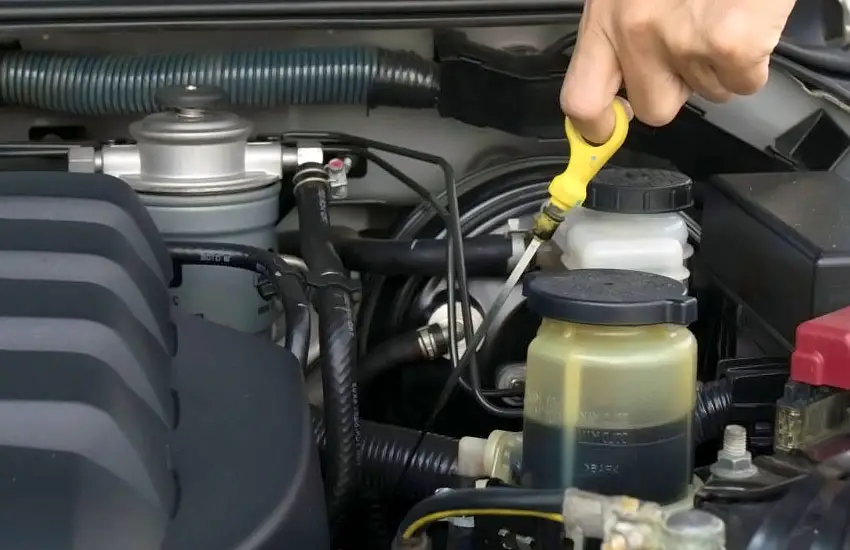As an Amazon Associate, I earn from qualifying purchases at no extra cost to you.
How to Check Automatic Transmission Fluid: Quick Steps
Have you ever experienced a moment when your car just doesn’t seem to run as smoothly as it used to? Maybe the gears are sticking, or there’s an unusual noise coming from the engine. Often, these issues can be traced back to a vital but sometimes overlooked component: the automatic transmission fluid (ATF). Understanding how to check your ATF is crucial for maintaining your car’s health and ensuring a smooth driving experience. In this comprehensive guide, we’ll walk you through everything you need to know about checking your automatic transmission fluid, ensuring your vehicle remains in peak condition.

The Importance of Checking Automatic Transmission Fluid
Automatic transmission fluid is essential for your vehicle’s transmission system. It serves as a lubricant, ensuring that all the moving parts within the transmission work smoothly together. Additionally, it helps cool the transmission, preventing overheating and potential damage. Without proper levels of clean transmission fluid, your car can suffer from various issues, leading to costly repairs and even total transmission failure.
Why Checking Transmission Fluid is Crucial
Transmission fluid plays several key roles in your car’s overall performance:
- Lubrication: Ensures the gears and other components work seamlessly without grinding against each other.
- Cooling: Keeps the transmission temperature down, preventing overheating.
- Hydraulic Function: Enables the transmission to shift gears efficiently.
- Protection: Protects against wear and tear, extending the lifespan of the transmission.
Neglecting to check and maintain your transmission fluid can lead to severe problems. Low or dirty fluid can cause the transmission to overheat, slip, or fail altogether. Regular checks and maintenance can help you avoid these issues and ensure your car runs smoothly.
When to Check Your Transmission Fluid
The frequency of checking your transmission fluid can vary depending on your vehicle’s make and model, your driving habits, and the manufacturer’s recommendations. However, a good rule of thumb is to check the fluid at least once a month. If you frequently drive in harsh conditions, such as extreme heat or heavy traffic, you might need to check it more often.
How to Know If Your Transmission Fluid Needs Attention
There are several signs that your transmission fluid might need to be checked or changed:
- Unusual noises: Grinding or whining sounds can indicate low or dirty fluid.
- Slipping gears: If your transmission slips out of gear, it could be due to inadequate fluid levels.
- Delayed shifting: A delay in shifting gears may be a sign that your fluid is low or contaminated.
- Leaking fluid: If you notice a red or brown fluid leak under your car, it might be transmission fluid.
- Burning smell: A burnt smell could indicate that the fluid is old and needs to be replaced.
Now that we understand the importance of transmission fluid and the signs that it needs attention, let’s dive into the step-by-step process of checking your automatic transmission fluid.
Step-by-Step Guide to Checking Your Automatic Transmission Fluid
Checking your automatic transmission fluid is a straightforward process that you can do at home with minimal tools. Here's a detailed guide to help you through it.
Preparing to Check the Fluid
Before you start, gather the necessary tools and materials. You’ll need:
- A clean rag or paper towel: To wipe the dipstick.
- A funnel: For adding fluid if necessary.
- Transmission fluid: Make sure it's the correct type for your vehicle (consult your owner’s manual).
- Gloves: To keep your hands clean.
- Safety goggles: To protect your eyes from any potential splashes.
Additionally, ensure your car is parked on a level surface and the engine is warm. Running your car for about 10-15 minutes should suffice to warm up the transmission fluid.
Finding the Transmission Dipstick
Most vehicles have a dipstick for checking the transmission fluid, similar to the one for checking engine oil. However, the location can vary:
- Front-wheel-drive vehicles: The dipstick is usually located near the front of the engine.
- Rear-wheel-drive vehicles: The dipstick is often towards the back of the engine.
Consult your owner’s manual if you're having trouble locating it.
Checking the Fluid Level
Once you’ve located the dipstick, follow these steps:
- Shift through the gears: With the engine running and the parking brake engaged, shift through each gear for a few seconds, then return to ‘Park.’ This ensures the fluid is distributed evenly.
- Remove the dipstick: Carefully pull out the dipstick and wipe it clean with a rag or paper towel.
- Reinsert the dipstick: Fully insert the dipstick back into the tube, then remove it again to check the fluid level.
- Read the level: Check where the fluid level is in relation to the markings on the dipstick. The dipstick will have indicators for ‘Full’ and ‘Add’ or ‘Low.’ The fluid should be within the recommended range. If it’s below the ‘Add’ or ‘Low’ mark, you need to add more fluid.
Checking the Fluid Condition
While you have the dipstick out, it’s also important to check the condition of the fluid. Here's what to look for:
- Color: Fresh transmission fluid is typically a bright red color. If it's brown or dark, it may be old and in need of replacement.
- Smell: The fluid should have a slightly sweet smell. A burnt odor indicates that the fluid is degraded and needs changing.
- Consistency: The fluid should be smooth and slightly oily. If it feels gritty or has particles in it, this could signal contamination.
Adding Transmission Fluid
If you need to add fluid, make sure to use the type specified in your owner’s manual. Here's how to add it:
- Insert the funnel: Place a funnel into the dipstick tube.
- Add fluid gradually: Pour in a small amount of transmission fluid at a time, checking the level frequently to avoid overfilling.
- Recheck the level: After adding fluid, reinsert the dipstick and check the level again to ensure it’s within the recommended range.
- Replace the dipstick: Once the fluid is at the correct level, securely replace the dipstick.
Final Steps
After checking and adjusting the fluid level:
- Drive your car: Take your car for a short drive to allow the new fluid to circulate through the transmission.
- Recheck the fluid: Park on a level surface and recheck the fluid level to ensure it's still within the recommended range.
Maintaining Your Transmission Fluid
Regular maintenance of your transmission fluid is key to keeping your car’s transmission in good condition. Here are some tips to help you maintain your transmission fluid:
Regular Fluid Changes
Most manufacturers recommend changing the transmission fluid every 30,000 to 60,000 miles. However, this can vary depending on your driving conditions and vehicle type. Always consult your owner’s manual for the manufacturer’s recommendations.
Monitor for Leaks
Regularly check under your car for signs of transmission fluid leaks. If you notice any fluid on the ground, have it checked by a professional mechanic as soon as possible.
Use the Right Fluid
Using the correct type of transmission fluid is crucial. Using the wrong fluid can cause damage to your transmission. Always refer to your owner’s manual to ensure you're using the appropriate fluid for your vehicle.
Professional Inspections
While checking and maintaining your transmission fluid is something you can do yourself, it's also a good idea to have your transmission inspected by a professional mechanic periodically. They can identify any potential issues that you might not notice.
Avoid Overheating
Transmission fluid helps to cool your transmission, so it's important to avoid conditions that can cause your transmission to overheat. This includes heavy towing, aggressive driving, and stop-and-go traffic. If you frequently drive in these conditions, you might need to check and change your transmission fluid more often.
Symptoms of Transmission Problems
Being aware of the symptoms of transmission problems can help you catch issues early and avoid costly repairs. Here are some common signs of transmission problems:
- Delayed engagement: If there's a delay when you shift from ‘Park’ to ‘Drive’ or ‘Reverse,’ this could indicate a problem with your transmission.
- Unusual noises: Grinding, whining, or clunking noises when shifting gears can be a sign of transmission issues.
- Slipping gears: If your transmission slips out of gear while driving, it's a clear sign that something is wrong.
- Check engine light: While the check engine light can indicate many different issues, it can also be triggered by transmission problems.
If you notice any of these symptoms, it's important to have your transmission checked by a professional mechanic as soon as possible.
I hope this guide has provided you with a clear understanding of how to check and maintain your automatic transmission fluid. Keeping your transmission fluid at the correct level and in good condition is essential for the health of your vehicle's transmission system. Regular checks and maintenance can help you avoid costly repairs and ensure a smooth driving experience.
Are These Questions in Your Mind?
Is it necessary to check transmission fluid regularly?
Yes, regular checks are crucial to ensure your transmission fluid is at the right level and in good condition, preventing potential transmission issues.
Can low transmission fluid cause my car to overheat?
Yes, low transmission fluid can lead to overheating as the fluid helps cool the transmission. Overheating can cause severe damage to your transmission.
Do I need to change my transmission fluid even if it’s not leaking?
Yes, transmission fluid degrades over time, losing its effectiveness. Regular changes are necessary to maintain proper lubrication and cooling.
Is it possible to add too much transmission fluid?
Yes, overfilling your transmission can cause foaming, leading to erratic shifting and potential damage. Always add fluid gradually and check the level frequently.
Can dirty transmission fluid affect my car's performance?
Yes, dirty fluid can cause issues such as slipping gears, delayed shifting, and increased wear on transmission components, leading to reduced performance.
Is it okay to use any type of transmission fluid?
No, always use the type of transmission fluid specified in your owner's manual. Using the wrong fluid can cause significant damage to your transmission.
Do I need a mechanic to check my transmission fluid?
While you can check your transmission fluid yourself, having a mechanic inspect it periodically is beneficial, as they can identify potential issues you might miss.
Can I check transmission fluid when the engine is cold?
It's best to check transmission fluid when the engine is warm and the car is on a level surface, as this ensures an accurate reading of the fluid level.
Is a burnt smell from the transmission fluid normal?
No, a burnt smell indicates that the fluid is degraded and needs to be changed. Burnt fluid can lead to transmission damage if not addressed promptly.
Do I need to check transmission fluid in a new car?
Yes, even new cars require regular maintenance, including checking transmission fluid levels to ensure optimal performance and longevity of the transmission system.











